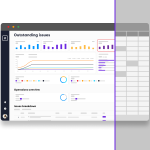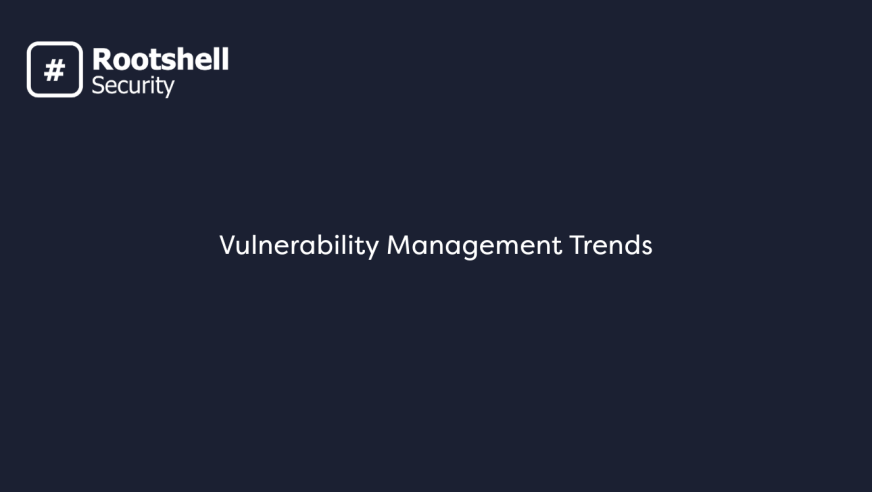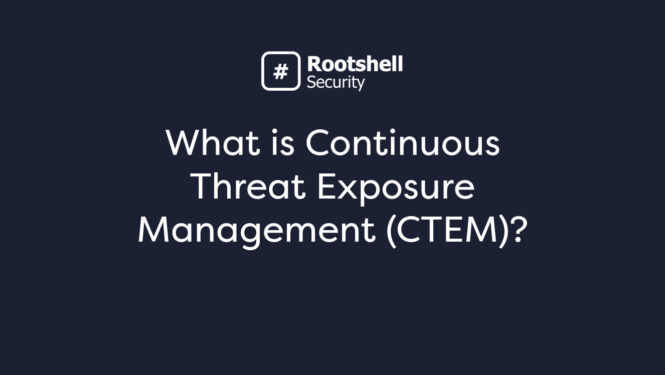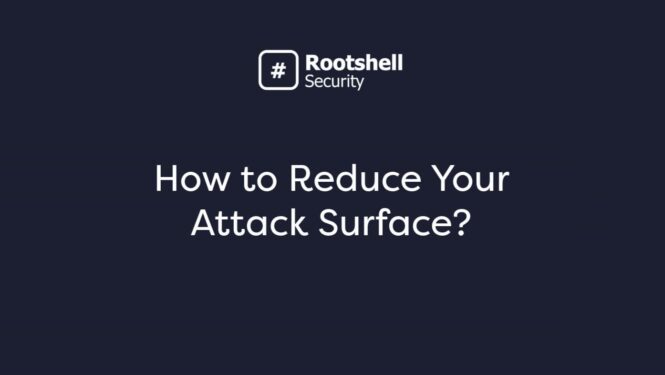In 2023, staying ahead of evolving threats is paramount as attacks from cybercriminals become daily occurrences. According to a survey done by Statista, internet-based attack is one of the fastest-growing security threat in the USA. At Rootshell Security, we understand the critical need to not only grasp the current industry landscape but also to anticipate emerging trends and challenges. In this blog post, we outline our top 14 vulnerability management trends and predictions for 2024.
Rootshell is your trusted partner in securing your digital assets and achieving maximum business impact. With 20+ years of experience in the industry, we’ve witnessed firsthand the rapid evolution of cyber threats. Conventional security measures are no longer enough. Today’s digital environment requires continuous cloud adoption and innovation. Here are some practical insights, strategies, and best practices we’ve developed through years of experience.
1. Shift to a Risk-Based Approach
The shift to a risk-based approach in vulnerability management reflects the evolving nature of the cyber industry. Organizations have recognized that it’s no longer practical to chase every potential vulnerability with equal favour. Instead, they prioritize their efforts based on factors like potential impact and exploitability. This approach is gaining prominence in the global security community as it allows organizations to allocate resources efficiently. It ensures that critical vulnerabilities are addressed promptly, reducing the risk of data breaches and aligning with the principle of sound risk management.
2. Asset Management and Prioritization
Asset management and prioritization have emerged as essential practices in vulnerability management due to the increasing complexity of digital infrastructures. In an era where organizations contend with a multitude of devices, applications, and data spanning diverse environments, gaining a holistic understanding of the digital landscape has become both a challenge and a necessity.
This trend recognizes that not all assets are created equal in terms of their criticality to business operations and security. It emphasizes the need for organizations to comprehensively identify and categorize their assets, taking into account their importance and potential impact on the organization. Asset management and prioritization allow organizations to focus their resources where they matter most, addressing vulnerabilities that pose the greatest risk and ultimately fortifying their defenses against the evolving threat landscape.
75% of organizations will use asset management to prioritize vulnerabilities by 2024, up from 50% today (Gartner, “2022 Magic Quadrant”).
3. Artificial Intelligence and Machine Learning Integration
The integration of AI and ML technologies into vulnerability management is revolutionizing how organizations approach security. AI and ML enable the analysis of vast amounts of data, allowing for more accurate and efficient identification of vulnerabilities. These advanced technologies empower organizations to automate repetitive tasks, detect emerging threats with precision, and improve response times. Their integration in vulnerability management solutions is a significant step forward in cybersecurity, enhancing a company’s ability to protect its digital assets effectively.

4. Continuous Vulnerability Assessment and Remediation
Gone are the days of periodic vulnerability scans. This practice involves ongoing, real-time monitoring of your security posture. By continuously scanning the attack surface for vulnerabilities and malware, organizations can identify and address emerging threats swiftly, reducing the window of opportunity for cyber attackers (read the difference between attack surface management vs vulnerability management here). Continuous assessment is a critical component of any modern vulnerability management strategy, as it aligns with the need for proactive defense and immediate remediation in the face of evolving cyber threats.
5. Integration of Vulnerability Management with DevOps
Traditional security practices, often relegated to post-development phases, have proven to be inadequate in an era where rapid software delivery is paramount.
This emerging trend recognizes that security can no longer be a standalone consideration but must be seamlessly woven into the fabric of the development process. It involves the incorporation of security checks, automated testing, and assessments directly into the DevOps pipeline. By doing so, organizations can proactively detect and remediate vulnerabilities early in the Software Development Lifecycle (SDLC). This paradigm shift not only enhances security but also fosters collaboration between development and security teams, streamlines processes, reduces costs, and ensures that security is not sacrificed in the pursuit of speed.
6. Cloud Integration
As more companies migrate their operations to the cloud, there’s an increased focus on cloud security. This trend stems from the recognition that cloud environments introduce unique security challenges. Companies must adapt their vulnerability management strategies to account for cloud-native vulnerabilities and configurations. Ensuring the security of data hosted in the cloud is a top priority, making cloud security a central aspect of modern vulnerability management in large enterprises and businesses of all sizes.
7. Zero-Trust Security Model
The zero-trust security model is moving away from the traditional notion of trusting entities within the corporate network. In this model, no user or system is inherently trusted, and continuous verification of identity and strict access controls are enforced. By implementing a zero-trust approach, businesses can mitigate the risk of insider threats and minimize the potential impact of external attacks, enhancing overall security posture.
8. Threat Hunting and Proactive Cybersecurity
The practice of threat hunting is gaining prominence as organizations recognize the need for proactive cybersecurity measures. Threat hunters actively seek signs of malicious activity within their network and systems. This approach enables security teams to identify and neutralize threats before they escalate into major incidents. It’s a proactive approach that complements continuous assessment, providing an additional layer of protection against evolving threats in.
9. Expanding Scope of Vulnerabilities
In today’s digital age, the scope of vulnerabilities extends beyond traditional software and network vulnerabilities. Organizations must now consider vulnerabilities in a broad range of areas, including IoT devices, cloud services, and supply chain vulnerabilities. This expanded scope highlights the need for a comprehensive and adaptive vulnerability management approach that covers all potential attack vectors, safeguarding against diverse threats.
10. Collaboration and Information Sharing
Collaboration through platforms like Information Sharing and Analysis Centers (ISACs) has become increasingly important. Sharing threat intelligence and best practices among organizations can significantly enhance collective cybersecurity.
11. Managed Vulnerability Management Services
The adoption of managed vulnerability management services is a growing trend among organizations looking to augment their in-house capabilities. These services provide expert assistance in identifying, prioritizing, and mitigating vulnerabilities, catering to organizations of all sizes. By leveraging managed vulnerability management services, organizations can enhance their security without the need for significant internal resources.
12. User Awareness and Training
While technology is a crucial component of vulnerability management, user awareness and training are equally important. Educating employees about cybersecurity best practices is essential to prevent human errors that often lead to data breaches.
13. Standards and Compliance
Meeting industry standards and compliance requirements is fundamental in vulnerability management. Adhering to these standards helps organizations demonstrate their commitment to security and protect against data breaches. Rootshell Security assists organizations in aligning with relevant standards and compliance frameworks, ensuring that security measures are in line with industry standard.
We’ll admit…it’s not really a trend for 2023 but more of a best practice.
14. Cyber Insurance
In the face of escalating cyber threats, cyber insurance has emerged as a vital risk management strategy. It provides financial protection in the event of a data breach, helping organizations recover and rebuild after a security incident. Read how to lower your cyber insurance premium here

Future Proof Protection with Rootshell Security
At Rootshell Security, we are at the forefront of the vulnerability management industry, providing comprehensive solutions to help organizations navigate the complex security landscape. Our flagship offering, the Rootshell platform, is designed to empower businesses with cutting-edge vulnerability management capabilities.
The Rootshell Platform: Your Partner in Vulnerability Management
Our platform is more than just a vulnerability management solution. With a relentless focus on innovation, our platform leverages AI and ML to deliver unparalleled accuracy in vulnerability detection and prioritization. It integrates seamlessly with your existing systems, ensuring a smooth and efficient workflow.
Key Features of our Platform:
- AI-Driven Vulnerability Detection: Our platform harnesses the power of artificial intelligence to identify vulnerabilities swiftly and accurately, bringing down your time-to-remediation. Say goodbye to false positives and wasted resources.
- Prioritization for Maximum Impact: The platform employs risk-based prioritization, ensuring that you address the most critical vulnerabilities first, minimizing your organization’s exposure to potential threats and increasing your visibility.
- Continuous Monitoring: Real-time vulnerability monitoring is at the core of Rootshell’s Platform, providing you with up-to-the-minute insights into your security posture.
- Integration with DevOps: We understand the importance of seamless integration with your development processes. The platform fits effortlessly into your DevOps pipeline, ensuring that security is a foundational element of your software development.
- User-Friendly Interface: Our platform features an intuitive interface, making it easy for security teams to manage vulnerabilities efficiently. Teams can also set up automation rules to make repetitive tasks a thing of the past.
In conclusion, as the vulnerability management landscape continues to evolve, staying informed about these trends and adopting best practices is essential for safeguarding your organization against data breaches and cyber threats.
By embracing risk-based approaches, integrating AI and ML technologies, and staying vigilant through continuous monitoring, you can bolster your security posture and ensure a safe future for your organization.
Only 20% of organizations have a vulnerability management program in place that meets best practices (Gartner, “2022 Magic Quadrant”), so don’t fall into the 80% or until the next data breach strikes—take proactive steps today to protect what matters most.
Contact Rootshell Security today to learn more about our vulnerability management solutions and future-proof your organization against emerging threats.



